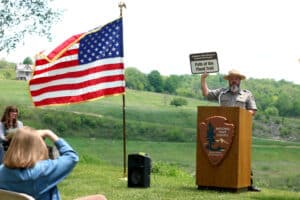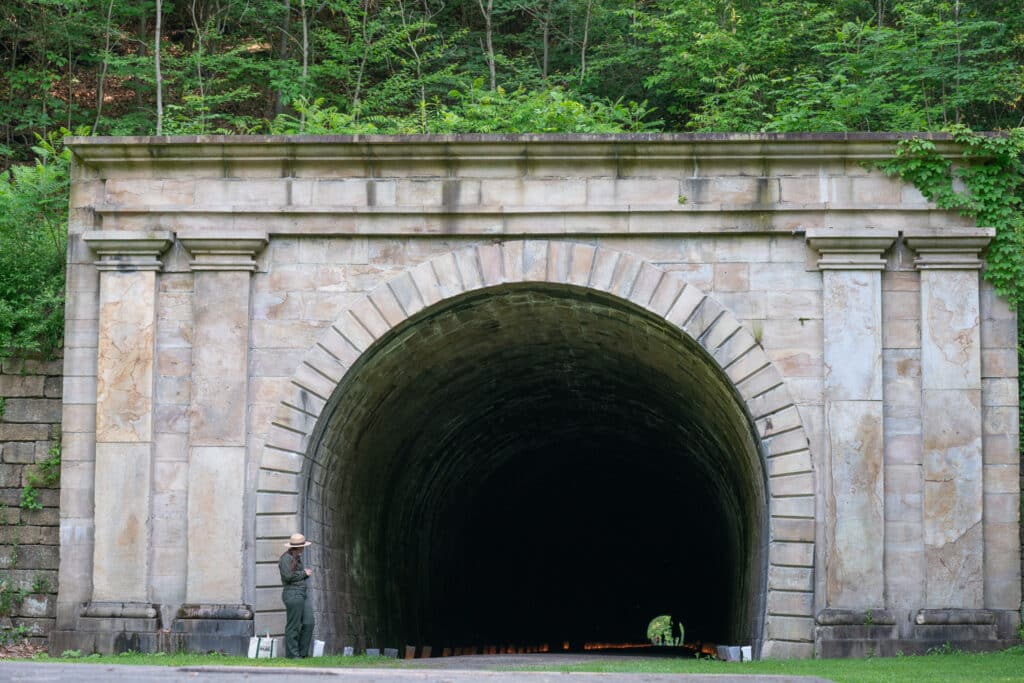News that the Path of the Flood Trail was named 2025 Pennsylvania Trail of the Year generated a lot of excitement at PEC. The 14-mile trail in Cambria County, which offers natural beauty, historic significance and community charm, illustrates the great potential for trails in the state to create places that people want to live, work, and play.
The Trails Advisory Committee, a group of volunteers chosen by the Pennsylvania Department of Conservation and Natural Resources (DCNR), selects the Trail of the Year to raise awareness of the Commonwealth’s extensive trail systems and the benefits they bring.

“Path of the Flood trail is a fine representation of the hard work, vision and dedication it requires to create a trail worthy of Trail of the Year,” said Brett Hollern, PEC Vice President for Western Pennsylvania. “With over 11,000 miles of trail in the Commonwealth, the recognition and attention the award brings is a nod to the unique experiences Path of the Flood offers. Like so many of PA’s trails, the Path of the Flood is part of a larger, still growing network of trails who are helping the region recognize the benefits of the outdoor recreation economy.”
The recognition marks a victory not just for the Path of the Flood Trail, managed by the Cambria County Conservation and Recreation Authority, but for outdoor recreation as a whole in southwestern Pennsylvania. It is part of the Trans Allegheny Trail System, a collaboration of trail operators in Southwest Pennsylvania that includes such popular trails as the Westmoreland Heritage and Ghost Town trails. PEC acts as the facilitator of the Trails Allegheny Trail Operating Group, convening managers to pursue a shared vision .

The trail passes through forests and meadows, including some reclaimed mining sites, as it traces the trajectory of the devastating 1889 flood, which released 20 million tons of water and killed more than 200 people. Along the way, trailside markers reveal historical details of that day, creating an immersive experience for trail users as they explore the beautiful Little Conemaugh River Valley that remains largely unchanged more than 130 years later. Other important landmarks include the nation’s first railroad tunnel — the Staple Bend Tunnel — and the restored home of Colonel Elias J. Unger, who had a commanding view of the South Fork Dam and tried in vain to prevent its destruction on the day of the flood.
The Path of the Flood Trail also lies along the 9/11 Memorial Trail corridor, which links the National September 11 Memorial and Museum in New York City, the National 9/11 Pentagon Memorial in Arlington, VA, and the Flight 93 National Memorial in Shanksville, PA.
“This trail is a destination, inviting visitors from across the nation and the world to experience the history of the 1889 Johnstown Flood while enjoying outdoor activities in a stunning natural setting,” DCNR Secretary Cindy Adams Dunn said in a news release. “We hope this designation will bring even more visitors to explore the trail, supporting local businesses and fostering economic, environmental, and social benefits for the region.”
The Path of the Flood trail draws an estimated 80,000 visitors to the region annually who contribute to the local economy and cultivate a thriving sense of community. The increasingly popular Path of the Flood Historic Races draw nearly 1,000 people each year.
DCNR’s goal is to ensure every Pennsylvanian lives within 10 minutes of a trail. Toward that end, PEC has helped to close priority trail gaps in the Commonwealth, including most recently the Brady Tunnel along the Armstrong Trails.
Learn more about what we are doing to support trail development and outdoor stewardship and how you can help by visiting pecpa.org/land.

